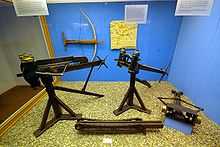Lithobolos
A lithobolos or stone thrower was an artillery weapon used in ancient warfare and medieval warfare. These machines threw stones of 10 lb to 180 lb in weight. They looked alike and differed only in size: the dimensions being calculated by a complex mathematical formula based on the spring diameter.[1]
History
The first recorded stonethrowers were used by the Macedonian army of Alexander the Great during the siege of Halicarnassus in 334 BC. According to the Hellenistic engineer Philo of Byzantium, the common effective range against fortifications was 150 metres (164 yd) with a load of 27 kilograms (60 lb); at that distance, walls had to be 5 metres (5.5 yd) thick to withstand the impact. Anti-personnel stonethrowers hurled much smaller balls, though arrow-shooters like the scorpio were preferred for these purposes. Super-heavy stonethrowers such as those fielded by Demetrius Poliorcetes in his siege of Rhodes (305-304 BC) threw stones of up to 75 kilograms (165 lb) and could be brought close to the walls in siege-towers. Balls of such size were found in small numbers in the arsenals of Carthage and Pergamon, corroborating ancient reports of their use. The Roman artillery engineer Vitruv provided measurements for even more powerful stone-throwers, but it is not known whether these were ever used in combat. Modern experiments show that smaller projectiles could be hurled at least 400–500 metres, while ancient authors record maximum ranges of as much as 700 metres (766 yd).
The Greeks, who wanted to protect the city of Syracuse against the Roman artillery had their own stonethrower made by Archimedes. [2] Archimedes called his stonethrower the lithobolos. [3] Another stone thrower was supposedly built by Charon of Magnesia.
See also
References
- ↑ Warry, J. (1995). Warfare in the Classical World. Pg.78 Salamander Books Ltd., London: United Kingdom. ISBN 0-8061-2794-5
- ↑ Lithobolos schematic
- ↑ Stone throwers
- ↑ Another greek stone thrower
- ↑ Palintonon also called "Palitones"
- ↑ Legion XXIV made Palintonon reconstruction
- ↑ Darius Architectus plans of siege engines
External links
- Greco Roman Artillery
- Reconstructions and Plans of Greek and Roman Artillery
- The BALLISTA Catapult
- Big Powerful Weapons
| ||||||||||||||||||||
